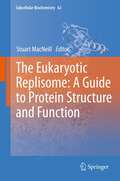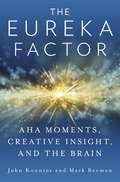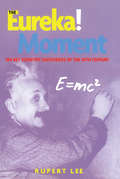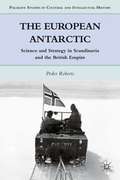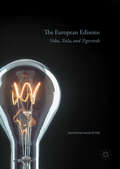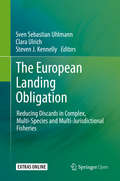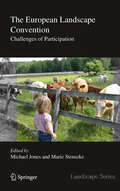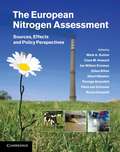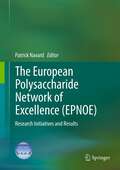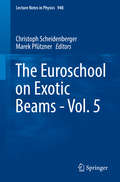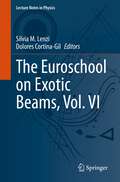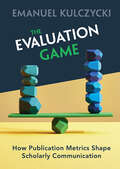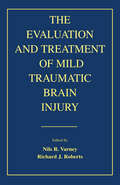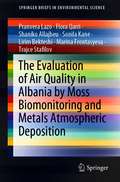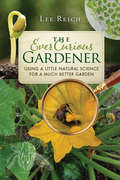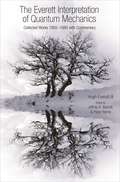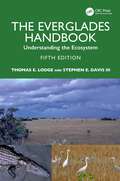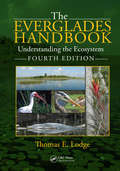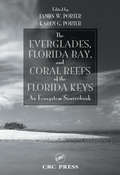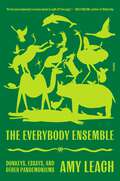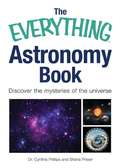- Table View
- List View
The Eukaryotic Replisome: a Guide to Protein Structure and Function
by Stuart MacneillHigh-fidelity chromosomal DNA replication underpins all life on the planet. In humans, there are clear links between chromosome replication defects and genome instability, genetic disease and cancer, making a detailed understanding of the molecular mechanisms of genome duplication vital for future advances in diagnosis and treatment. Building on recent exciting advances in protein structure determination, the book will take the reader on a guided journey through the intricate molecular machinery of eukaryotic chromosome replication and provide an invaluable source of information, ideas and inspiration for all those with an interest in chromosome replication, whether from a basic science, translational biology and medical research perspective.
The Eureka Factor
by John Kounios Mark BeemanIn a book perfect for readers of Charles Duhigg's The Power of Habit, David Eagleman's Incognito, and Leonard Mlodinow's Subliminal, the cognitive neuroscientists who discovered how the brain has aha moments--sudden creative insights--explain how they happen, when we need them, and how we can have more of them to enrich our lives and empower personal and professional success. Eureka or aha moments are sudden realizations that expand our understanding of the world and ourselves, conferring both personal growth and practical advantage. Such creative insights, as psychological scientists call them, were what conveyed an important discovery in the science of genetics to Nobel laureate Barbara McClintock, the melody of a Beatles ballad to Paul McCartney, and an understanding of the cause of human suffering to the Buddha. But these moments of clarity are not given only to the famous. Anyone can have them. In The Eureka Factor, John Kounios and Mark Beeman explain how insights arise and what the scientific research says about stimulating more of them. They discuss how various conditions affect the likelihood of your having an insight, when insight is helpful and when deliberate methodical thought is better suited to a task, what the relationship is between insight and intuition, and how the brain's right hemisphere contributes to creative thought. Written in a lively, engaging style, this book goes beyond scientific principles to offer productive techniques for realizing your creative potential--at home and at work. The authors provide compelling anecdotes to illustrate how eureka experiences can be a key factor in your life. Attend a dinner party with Christopher Columbus to learn why we need insights. Go to a baseball game with the director of a classic Disney Pixar movie to learn about one important type of aha moment. Observe the behind-the-scenes arrangements for an Elvis Presley concert to learn why the timing of insights is crucial. Accessible and compelling, The Eureka Factor is a fascinating look at the human brain and its seemingly infinite capacity to surprise us. Praise for The Eureka Factor "Delicious . . . In The Eureka Factor, neuroscientists John Kounios and Mark Beeman give many other examples of [a] kind of lightning bolt of insight, but back this up with the latest brain-imaging research."--Newsweek "An excellent title for those interested in neuroscience or creativity . . . The writing is engaging and readable, mixing stories of famous perceptions with explanations of how such revelations happen, and including suggestions throughout to help people become more insightful."--Library Journal (starred review) "Kounios and Beeman, distinguished neuroscientists with more than twenty years of cognitive research to their credit, examine such incidents of insight, juxtaposing the mere wonder of it all with the quantifiable science behind how the brain functions. . . . Knowing how and when the brain can spark at maximum responsiveness can open up a world of inventiveness and inspiration. A lively and accessible 'brain' book with wide appeal."--Booklist"Readers curious to know what happens when we solve a problem in a flash will find the latest research here [and] will appreciate [this] ingenious, thoughtful update on how the mind works."--Kirkus Reviews "The Eureka Factor presents a fascinating and illuminating account of the creative process and how to foster it."--James J. Heckman, Nobel laureate in economicsFrom the Hardcover edition.
The Eureka! Moment: 100 Key Scientific Discoveries of the 20th Century
by Rupert LeeFirst Published in 2003. Routledge is an imprint of Taylor & Francis, an informa company.
The European Antarctic
by Peder RobertsThis is the first transnational study of British, Norwegian, and Swedish engagement with the Antarctic. Rather than charting how Europeans unveiled the Antarctic, it uses the history of Antarctic activity as a window into the political and cultural worlds of twentieth-century Britain and Scandinavia.
The European Edisons
by Anand Kumar SethiThis book explores the lives, inventions, discoveries, and significant work of three extraordinary European inventors with noteworthy links to the great Thomas Alva Edison - Alessandro Volta, Nikola Tesla, and Eric Tigerstedt. It explores the business and scientific legacies that these men have contributed to the modern world. Despite prejudices, ill health, financial stringency, geopolitical situations, business rivalries, and in many cases just awful luck, they remained determined to deliver extraordinary scientific and technological developments to a skeptical and unappreciative world. This book is a testament to anyone pursuing their technological dreams for the benefit of society, and will enhance the literature for scholars, researchers, and the well-informed reader with an interest in science, technology, and the personalities involved in history.
The European Landing Obligation: Reducing Discards In Complex, Multi-species And Multi-jurisdictional Fisheries
by Sven Sebastian Uhlmann Clara Ulrich Steven J. KennellyThis open access book provides a comprehensive examination of the European Landing Obligation policy from many relevant perspectives. It includes evaluations of its impacts at economical, socio-cultural, ecological and institutional levels. It also discusses the feasibility and benefits of several potential mitigation strategies. The book was timely published, exactly at the time where the Landing Obligation was planned to be fully implemented. This book is of significant interest to all stakeholders involved, but also to the general public of Europe and to other jurisdictions throughout the world that are also searching for ways to deal with by-catch and discard issues.
The European Landing Obligation: Reducing Discards in Complex, Multi-Species and Multi-Jurisdictional Fisheries
by Sven Sebastian Uhlmann Clara Ulrich Steven J. KennellyThis open access book provides a comprehensive examination of the European Landing Obligation policy from many relevant perspectives. It includes evaluations of its impacts at economical, socio-cultural, ecological and institutional levels. It also discusses the feasibility and benefits of several potential mitigation strategies. The book was timely published, exactly at the time where the Landing Obligation was planned to be fully implemented. This book is of significant interest to all stakeholders involved, but also to the general public of Europe and to other jurisdictions throughout the world that are also searching for ways to deal with by-catch and discard issues.
The European Landscape Convention
by Michael Jones Marie StensekeThis important and insightful book provides, for the first time, a broad presentation of ongoing research into public participation in landscape conservation, management and planning, following the 2000 European Landscape Convention which came into force in 2004. The book examines both the theory of participation and what lessons can be learnt from specific European examples. It explores in what manner and to what extent the provisions for participation in the European Landscape Convention have been followed up and implemented. It also presents and compares different experiences of participation in selected countries from northern, southern, eastern and western Europe, and provides a critical examination of public participation in practice. However, while the book's focus is necessarily on Europe, many of the conclusions drawn are of global relevance. The book provides a valuable reference for researchers and advanced students in landscape policies and management, as well as for professionals and others interested in land-use planning and environmental management.
The European Nitrogen Assessment
by Clare M. Howard Mark A. Sutton Jan Willem Erisman Gilles Billen Hans Van Grinsven Bruna Grizzetti Peringe Grennfelt Albert BleekerPresenting the first continental-scale assessment of reactive nitrogen in the environment, this book sets the related environmental problems in context by providing a multidisciplinary introduction to the nitrogen cycle processes. Issues of upscaling from farm plot and city to national and continental scales are addressed in detail with emphasis on opportunities for better management at local to global levels. The five key societal threats posed by reactive nitrogen are assessed, providing a framework for joined-up management of the nitrogen cycle in Europe, including the first cost-benefit analysis for different reactive nitrogen forms and future scenarios. Incorporating comprehensive maps, a handy technical synopsis and a summary for policy makers, this landmark volume is an essential reference for academic researchers across a wide range of disciplines, as well as stakeholders and policy makers. It is also a valuable tool in communicating the key environmental issues and future challenges to the wider public.
The European Polysaccharide Network of Excellence (EPNOE)
by Patrick NavardThis book provides an essential overview of the science of polysaccharides. It both approaches polysaccharides as a polymer class and provides detailed descriptions of most major polysaccharides (cellulose, mannan, xylan, chitin-chitosan, cyclodextrines). Owing to the multidisciplinary character of the European Polysaccharide Network of Excellence (EPNOE), the book describes all main aspects of polysaccharide science and technology (biology, enzymology, physics, chemistry, materials science and processing). Notations and concepts follow a uniform format throughout the whole work in order to create a valuable reference book on the field of polysaccharide science. Owing to the major importance of industry in the EPNOE, concrete applications are also described in detail.
The Euroschool on Exotic Beams - Vol. 5 (Lecture Notes in Physics #948)
by Christoph Scheidenberger Marek PfütznerThis is the fifth volume in a series of Lecture Notes based on the highly successful Euro Summer School on Exotic Beams.The aim of these notes is to provide a thorough introduction to radioactive ion-beam physics at the level of graduate students and young postdocs starting out in the field.Each volume covers a range of topics from nuclear theory to experiment and applications. Vol I has been published as LNP 651, Vol II as LNP 700, Vol. III as LNP 764 and Vol. IV as LNP 879.
The Euroschool on Exotic Beams, Vol. VI (Lecture Notes in Physics #1005)
by Silvia M. Lenzi Dolores Cortina-GilThis book is based on the lectures given at the “Euroschool on Exotic Beams” and collects contributions which address topics from the traditional core of the field of exotic nuclei like nuclear structure far from stability, discussing recent theoretical developments and state-of-the-art experimental methods. It provides also new perspectives in nuclear astrophysics and in applied areas such as gamma-ray emission imaging. The contributions are written with a pedagogical approach and carefully edited in order to provide the readership with a clear and fluent reading. The book is intended for PhD students and young researchers who are approaching the new research lines in nuclear physics with exotic nuclei. Only basics concepts on quantum mechanics and nuclear physics are requested to follow and master the covered arguments.
The Evaluation Game: How Publication Metrics Shape Scholarly Communication
by Emanuel KulczyckiScientific research is communicated, organized, financed, governed, and evaluated through the process of publication. The result of this process is a highly competitive academic environment that rewards researchers for high volume publication, preferably in high-impact journals, leading to the popularised expression 'publish or perish'. Universities and other scientific institutions are under similar pressure, with their aggregated research output being under constant scrutiny. This innovative text provides a detailed introduction to the origin and development of the scholarly metrics used to measure academic productivity, and the effect they have upon the quality and diversity of scientific research. With its careful attention to both the positive and negative outcomes of research evaluation and their distinct expressions around the globe, The Evaluation Game guides the way to a more grounded understanding of metrics, and the diverse academic cultures they give rise to.
The Evaluation and Measurement Of Library Services, 2nd Edition
by Joseph R. MatthewsThis guide provides library directors, managers, and administrators in all types of libraries with complete and up-to-date instructions on how to evaluate library services in order to improve them. <P><P> It's a fact: today's libraries must evaluate their services in order to find ways to better serve patrons and prove their value to their communities. In this greatly updated and expanded edition of Matthews' seminal text, you'll discover a breadth of tools that can be used to evaluate any library service, including newer tools designed to measure customer and patron outcomes. <P><P> The book offers practical advice backed by solid research on virtually every aspect of evaluation, including quantitative and qualitative tools, data analysis, and specific recommendations for measuring individual services, such as technical services and reference and interlibrary loan. New chapters give readers effective ways to evaluate critical aspects of their libraries such as automated systems, physical space, staff, performance management frameworks, eBooks, social media, and information literacy. <P><P> The author explains how broader and more robust adoption of evaluation techniques will help library managers combine traditional internal measurements, such as circulation and reference transactions, with more customer-centric metrics that reflect how well patrons feel they are served and how satisfied they are with the library. By applying this comprehensive strategy, readers will gain the ability to form a truer picture of their library's value to its stakeholders and patrons.
The Evaluation and Treatment of Mild Traumatic Brain Injury
by Nils R. Varney Richard J. RobertsMoving beyond the debate over whether and to what degree mild head injury has lasting neuropsychological sequelae, this book is predicated on the assumption that it does cause some problems in some circumstances for some people. It focuses on the practical questions of who is injured, how injuries manifest themselves, and what evaluation and treatment strategies are optimal, for families as well as patients. The distinguished authors bring to their task not only scientific expertise but extensive day-to-day clinical experience. This book will be widely welcomed as the first comprehensive overview of what we have learned from research and clinical experience about these difficult cases.
The Evaluation of Air Quality in Albania by Moss Biomonitoring and Metals Atmospheric Deposition (SpringerBriefs in Environmental Science)
by Pranvera Lazo Flora Qarri Shaniko Allajbeu Sonila Kane Lirim Bekteshi Marina Frontasyeva Trajce StafilovThis book provides an overview of air quality in Albania evaluated by moss biomonitoring and metals atmospheric deposition. It is based on the concentration data onto 51 elements in moss samples collected during 2010/2011 moss biomonitoring survey conducted at the same time with European moss biomonitoring survey. The elements under investigation were determined by using ICP-AES and ENAA analytical techniques. Moss species Hypnum cupressiforme (Hedw) sps., a carpet-forming bryophyte, was used as bioindicator of trace metal atmospheric deposition. The goal of this study was to identify factors leading to the high levels of trace metals in at-mospheric deposition in Albania, to identify the risk factors and the origin of trace metals in atmos-pheric deposition. It may help the policy makers and regulators to take proper decisions to protect the public health and the environment. The distribution pattern of the elements was visualized by using the geographic information system, GIS 10.2. The predicted trends of the distribution were calculated by using time series (linear model) and the areas with high concentration of certain met-als were suggested for monitoring and to be under control.
The Evaluation of Forensic DNA Evidence
by Committee on DNA Forensic Science: An UpdateIn 1992 the National Research Council issued DNA Technology in Forensic Science, a book that documented the state of the art in this emerging field. Recently, this volume was brought to worldwide attention in the murder trial of celebrity O. J. Simpson. The Evaluation of Forensic DNA Evidence reports on developments in population genetics and statistics since the original volume was published. The committee comments on statements in the original book that proved controversial or that have been misapplied in the courts. This volume offers recommendations for handling DNA samples, performing calculations, and other aspects of using DNA as a forensic tool--modifying some recommendations presented in the 1992 volume. The update addresses two major areas: Determination of DNA profiles. The committee considers how laboratory errors (particularly false matches) can arise, how errors might be reduced, and how to take into account the fact that the error rate can never be reduced to zero. Interpretation of a finding that the DNA profile of a suspect or victim matches the evidence DNA. The committee addresses controversies in population genetics, exploring the problems that arise from the mixture of groups and subgroups in the American population and how this substructure can be accounted for in calculating frequencies. This volume examines statistical issues in interpreting frequencies as probabilities, including adjustments when a suspect is found through a database search. The committee includes a detailed discussion of what its recommendations would mean in the courtroom, with numerous case citations. By resolving several remaining issues in the evaluation of this increasingly important area of forensic evidence, this technical update will be important to forensic scientists and population geneticists--and helpful to attorneys, judges, and others who need to understand DNA and the law. Anyone working in laboratories and in the courts or anyone studying this issue should own this book.
The Event Horizon: Homo Prometheus and the Climate Catastrophe
by Andrew Y. GliksonWith the advent of global warming and the nuclear arms race, humans are rapidly approaching a moment of truth. Technologically supreme, they manifest their dreams and nightmares in the real world through science, art, adventures and brutal wars, a paradox symbolized by a candle lighting the dark yet burning away to extinction, as discussed in this book. As these lines are being written, fires are burning on several continents, the Earth’s ice sheets are melting and the oceans are rising, threatening to flood the planet’s coastal zones and river valleys, where civilization arose and humans live and grow food. With the exception of birds like hawks, black kites and fire raptors, humans are the only life form utilizing fire, creating developments they can hardly control. For more than a million years, gathered around campfires during the long nights, mesmerized by the flickering life-like dance of the flames, prehistoric humans acquired imagination, a yearning for omnipotence, premonitions of death, cravings for immortality and conceiving the supernatural. Humans live in realms of perceptions, dreams, myths and legends, in denial of critical facts, waking up for a brief moment to witness a world that is as beautiful as it is cruel. Existentialist philosophy offers a way of coping with the unthinkable. Looking into the future produces fear, an instinctive response that can obsess the human mind and create a conflict between the intuitive reptilian brain and the growing neocortex, with dire consequences. As contrasted with Stapledon’s Last and first Man, where an advanced human species mourns the fate of the Earth, Homo sapiens continues to transfer every extractable molecule of carbon from the Earth to the atmosphere, the lungs of the biosphere, ensuring the demise of the planetary life support system.”
The Ever Curious Gardener: Using a Little Natural Science for a Much Better Garden
by Lee ReichAn irreverent romp through the natural science of gardening, with eye-opening insight and practical guidance for getting the most out of your plants.Curious why caressing your cucumber plants will help them bear more fruit? Or why you should grow oranges from seed even if the fruit is inedible? Or why trees need to sleep and how to help them? Join acclaimed gardener, scientist, and author Lee Reich on a journey through the delights of your garden in this laugh-out-loud treatise on the scientific wonders of plants and soil.The Ever Curious Gardener includes information on:How to maximize both flavor and nutrition in your garden bountyHelping plants thrive during droughtOutwitting weeds by understanding their natureMaking the best use of compostTips on pruning and orchard careWhy the dead language of Latin can make you a better gardener.
The Everett Interpretation of Quantum Mechanics: Collected Works 1955-1980 with Commentary
by Jeffrey A. Barrett and Peter ByrneHugh Everett III was an American physicist best known for his many-worlds interpretation of quantum mechanics, which formed the basis of his PhD thesis at Princeton University in 1957. Although counterintuitive, Everett's revolutionary formulation of quantum mechanics offers the most direct solution to the infamous quantum measurement problem--that is, how and why the singular world of our experience emerges from the multiplicities of alternatives available in the quantum world. The many-worlds interpretation postulates the existence of multiple universes. Whenever a measurement-like interaction occurs, the universe branches into relative states, one for each possible outcome of the measurement, and the world in which we find ourselves is but one of these many, but equally real, possibilities. Everett's challenge to the orthodox interpretation of quantum mechanics was met with scorn from Niels Bohr and other leading physicists, and Everett subsequently abandoned academia to conduct military operations research. Today, however, Everett's formulation of quantum mechanics is widely recognized as one of the most controversial but promising physical theories of the last century. In this book, Jeffrey Barrett and Peter Byrne present the long and short versions of Everett's thesis along with a collection of his explanatory writings and correspondence. These primary source documents, many of them newly discovered and most unpublished until now, reveal how Everett's thinking evolved from his days as a graduate student to his untimely death in 1982. This definitive volume also features Barrett and Byrne's introductory essays, notes, and commentary that put Everett's extraordinary theory into historical and scientific perspective and discuss the puzzles that still remain.
The Everglades Handbook: Understanding the Ecosystem
by Thomas E. Lodge Stephen E. Davis IIIThe Everglades Handbook: Understanding the Ecosystem, Fifth Edition is packed with scientific information about the greater Everglades ecosystem, taking into account how drastically the Everglades has changed. The book covers disciplines ranging from ecology, geology, climatology, hydrology, simplified biogeochemistry, and anthropology to conservation biology. The fifth edition of this bestselling guide presents expanded treatment of subjects where our knowledge of the Everglades and its restoration has greatly improved as well as updates throughout. This more detailed coverage includes a new chapter ‘Everglades Chemistry – A Primer’ and an expanded section on the role of human intervention in Everglades restoration, as well as numerous new graphics that bring the science to life. Written in Tom Lodge’s trademark accessible style combined with the expertise of new coauthor Stephen E. Davis III, Chief Science Officer with the Everglades Foundation, this extensively researched text is essential reading for anybody trying to understand the challenges we face in restoring this unique ecosystem.
The Everglades Handbook: Understanding the Ecosystem, Fourth Edition
by Thomas E. Lodge"This fourth edition covers the key subjects of previous editions with major updates of the new science and understanding. If there ever was a necessary book for Everglades advocates, students, authors, members of government and their agencies, The Everglades Handbook: Understanding the Ecosystem is an absolute must!" —Nathaniel P. Reed, from the Foreword “This book is far and away the best guide now in print to Everglades issues -- authoritative, well-illustrated, well-indexed, and readable." — Martha Musgrove, retired Miami Herald journalist, founding President of the Decision Makers Forum, and Southeast Regional Director of the Florida Wildlife Federation "Given the astonishing breadth and depth of scientific activities in the Everglades, Tom Lodge once again illustrates his savvy as an articulate science writer in condensing the complex dynamics of this remarkable ecosystem. …In summary, the Handbook reviews a vast literature into a compelling read about the natural treasures of the Everglades."—Evelyn E. Gaiser, Executive Director, School of Environment, Arts and Society, and Associate Dean, College of Arts & Sciences, Florida International University, modified from Wetlands (2011) 31 _____________________________________________________________________________________ The fourth edition presents expanded treatment of subjects where our knowledge of the Everglades and its restoration has greatly improved. This more detailed coverage includes: Computer modeling and its applications to the Everglades environment Quantified role of water flow in shaping the Everglades landscape The origin and evolution of fixed tree islands Sulfur and related mercury as wetland pollutants Up-to-date summary of the now quantified economic benefits of restoration, shown to be far in excess of the cost The Everglades Handbook: Understanding the Ecosystem, Fourth Edition is a scholarly reference packed cover to cover with scientific information about the ecosystem of the Everglades - taking into account how drastically the Everglades has changed. Topically, the book covers disciplines ranging from ecology, geology, climatology, hydrology, anthropology to conservation biology. Written in Tom Lodge’s trademark accessible style, this extensively researched text is essential reading for anybody trying to understand the challenges we face in restoring this unique ecosystem.
The Everglades, Florida Bay, and Coral Reefs of the Florida Keys: An Ecosystem Sourcebook
by James W. Porter Karen G. PorterProviding a synthesis of basic and applied research, The Everglades, Florida Bay, and Coral Reefs of the Florida Keys: An Ecosystem Sourcebook takes an encyclopedic look at how to study and manage ecosystems connected by surface and subsurface water movements. The book examines the South Florida hydroscape, a series of ecosystems linked by hydrolog
The Everybody Ensemble: Donkeys, Essays, and Other Pandemoniums
by Amy LeachIn short, gloriously inventive essays, Whiting Award-winning author Amy Leach's The Everybody Ensemble invites us to see and celebrate our oddball, interconnected worldHumans, please turn your guns into kazoos.Are you feeling dismay, despair, disillusion? Need a break from the ho-hum, the hopeless, and the hurtful? Feel certain that there’s a version of our world that doesn’t break down into tiny categories of alliance but brings everybody together into one clattering, sometimes discordant but always welcoming chorus of glorious pandemonium?Amy Leach, the celebrated author of the transcendent Things That Are, invites you into The Everybody Ensemble, an effervescent tonic of a book. These short, wildly inventive essays are filled with praise songs, poetry, ingenious critique, soul-lifting philosophy, music theory, and whimsical but scientific trips into nature. Here, you will meet platypuses, Tycho Brahe and his moose, barnacle goslings, medieval mystics, photosynthetic bacteria, and a wholly fresh representation of the biblical Job.Equal parts call to reason and to joy, this book is an irrepressible celebration of our oddball, interconnected world. The Everybody Ensemble delivers unexpected wisdom and a wake-up call that sounds from within. For readers of Ross Gay, Eula Biss, Anne Lamott, Annie Dillard, Ralph Waldo Emerson, and even Lewis Carroll, these twenty-four essays will be a perfect match.
The Everything Astronomy Book
by Shana Priwer Dr Cynthia PhillipsThe Everything Astronomy Book, by noted SETI Institute scientist Dr. Cynthia Phillips, helps you stargaze with authority. The book not only provides clear descriptions of all the theories of the origins of the universe, it explains the facts about the planets, moons, and stars in language anyone can understand-completely free of the usual astro-jargon. In addition, common myths are debunked: Find out why the Big Dipper is not an actual constellation, and that a shooting star isn't really a star at all!
